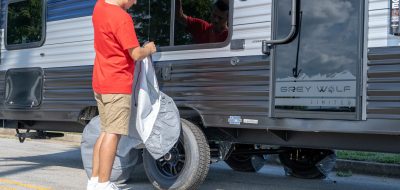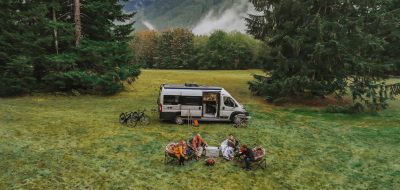 It’s safe to say that RV camping is firmly established as a classic American tradition. According to the Recreation Vehicle Industry Association (RVIA), approximately 30 million Americans are on record as either owning or having rented RVs. In the United States, the rental sector of the RV industry is a booming $350 million enterprise that just keeps expanding. And as RV camping’s popularity grows throughout the USA, so does the range of locations where enthusiastic RVers travel.
It’s safe to say that RV camping is firmly established as a classic American tradition. According to the Recreation Vehicle Industry Association (RVIA), approximately 30 million Americans are on record as either owning or having rented RVs. In the United States, the rental sector of the RV industry is a booming $350 million enterprise that just keeps expanding. And as RV camping’s popularity grows throughout the USA, so does the range of locations where enthusiastic RVers travel.
While American RVers can choose from a non-stop diversity of some 16,000 domestic campgrounds — from rustic to regal — many present-day travelers are broadening their horizons and researching reasonable options for camping beyond U.S. borders. In light of the burgeoning interest in international RVing, let’s look at some likely foreign destinations.
RVing in Canada
Canada is one of America’s immediate neighbors and, as such, it’s a country that’s fairly familiar to much of the state-side RVing population. Because of Canada’s close proximity to (and positive relations with) the U.S., it’s a natural magnet for internationally-minded American travelers, many of whom drive their own RVs across Canada’s borders every year.
According to statistics compiled by Go RVing Canada (a coalition of RV manufacturers, dealers and campground operators), the number of RVs on Canadian roadways exceeds 1 million, and 14% of Canadian households include recreational vehicle owners. If you decide to drive your family’s RV into Canada, it’s important to keep in mind that regulations for RV operation (related to vehicle size limits, seat belt use, safety chains, and brakes) are specific for each province. You can obtain a summary of the various regulations from the Recreation Vehicle Dealers Association of Canada.
Renting an RV in Canada is virtually trouble free, with hundreds of outlets available throughout Canada’s diverse landscapes — from pristine island shores and deep green forests to rushing waterfalls and frosted mountain peaks. RV rental prices are variable, of course, depending upon your intended travel season and chosen locations.
Canadian campgrounds are abundant and welcoming to American tourists. Everyone can find an ideal place to stay in Canada’s far-flung mix of thousands of national, provincial and commercial parks. And fascinating sights and sounds are virtually everywhere you go. There’s no shortage of country-wide festivals, engaging museums and historical attractions. And there are grand events and not-to-miss locales — such as Quebec City’s Winter Carnival, Calgary’s famed Stampede and Victoria, British Columbia’s fabulous gardens — which you can add to your Canadian RV itinerary.
RVing in Europe
RV camping in Europe is a bit more of a leap of faith than an RV trip to close-by Canada might be. In their RV Know-How article entitled “RVing Europe,” Joe and Vicki Kieva discuss the highlights of their European motorhome tour. As part of a well-organized commercial caravan of 15 RVs, the Kievas successfully steered their 18-foot, five-speed, four-cylinder, diesel Class C rental through Austria, Belgium, Germany, Holland, Liechtenstein, and Switzerland.
Since the Kievas are recognized experts in their field (and because my family has never RVed in Europe), I’m inclined to trust their European camping synopsis, which was overwhelmingly positive.
In their article, European autobahns and main highways are described by Joe Kieva as “visitor friendly.” Joe says they are comparable to American interstates and highways, with reasonable numbers of picnic areas and “travel plazas” — equipped with fuel, propane, food, rest rooms, and shopping venues. However, he cautions that driving and parking in cities and towns is very difficult. To avoid driving hassles, he suggests parking your RV elsewhere and boarding public transportation or using a bicycle for metro excursions.
Vicki Kieva characterizes European campgrounds as numerous throughout the countries she and Joe visited, with concentrations of parks near major cities and in popular tourist areas. She says that water and sewer connections are somewhat scarce, and electrical hook-ups are more communal than in the U.S. They sometimes require extension cords up to 80 feet in length. Travelers who are carrying American electrical appliances need to pack a transformer and plug adaptor to use (and safeguard) their electronics. And by the way, Vicki gives high marks to European restrooms and shower facilities, calling them “modern and immaculate.”
RVing in South Africa
Locating a recreational vehicle rental in “The Rainbow Nation” of South Africa is an easy task, since RV camping is a popular pastime there. In a far-away land of gold, diamonds, beaches, mountains, deserts, and nature reserves with exotic wildlife, reliable companies such as KEA and Maui (and many others) offer campervan and motorhome rentals. Pick-up/drop-off depots are situated in convenient locales, and companies like KEA provide clients with maps, route recommendations, and campground guides. As a special bonus for the wanderlust crowd, extended travels into Botswana, Zimbabwe, Mozambique, and Namibia are surcharge-free.
According to information provided online by Motorhomes Worldwide (southern Africa’s caravanning and camping tourism network), South African roads are “generally good” for maneuvering motorhomes, especially between major cities and towns. The climate cooperates, too, because it is agreeable for camping on a year-round basis. It should be noted that rural roadways are of inconsistent quality, in terms of RV travel. And keep in mind that South Africans drive on the left side of the road and pass on the right. Use of seat belts is legally mandated.
The Motorhomes Worldwide website states that South African campgrounds are plentiful. Parks are designed to accommodate tents as well as campervans or motorhomes. Campsites are usually quite crowded during school holidays, so it’s best to schedule your trip to South Africa during alternate times.
RVing in Australia and New Zealand
Finding an RV to rent ‘Down Under’ in Australia or New Zealand is a “no-worries” proposition. There are numerous rental outlets in both countries, where gorgeous beaches, bounding kangaroos, rainforests, kiwis, glaciers, and sacred Aboriginal grounds might come into view. Compact campervans and Class C motorhomes are available through dependable suppliers such as KEA, Maui, Britz, and Apollo. During my family’s recent RV trip in Australia, we rented a 22-foot KEA motorhome through Eddie Teh at Aussie Campervans & Car Rentals. Teh’s expert customer service and the reserved KEA both exceeded our expectations.
With the notable exception of well-maintained major highways connecting large cities, Australia’s and New Zealand’s road systems are not comparable to those in the U.S. On most roads, you probably won’t be able to drive at speeds considered normal in America. Travel between small towns and on rural roads can be challenging for drivers of RVs. But the awesome scenery and warm-hearted, fun-loving people you meet in Australia and New Zealand make the relatively slow travel pace worthwhile. You should anticipate long distances between sources of fuel, water, and food. It’s actually wise to refuel your rig and re-stock the galley whenever such opportunities arise.
Campgrounds in Australia and New Zealand are called “caravan parks,” “holiday parks,” and “tourists’ parks” by the locals. Park networks and camping membership clubs are commonplace. Accommodations are generally neat and clean, camp kitchens are well-equipped, and managers are most often helpful, friendly, and pro-American in their attitudes. Many national parks offer rustic campsites, and some even offer RV-ready spots, as well. In New Zealand, you can stay at Department of Conservation camps in unbelievably beautiful settings (with minimal facilities). Commercial RV parks Down Under have hookups for electricity, freshwater, and grey water at most campsites, plus centralized black water dump stations. As in most countries (including the United States), there are marked seasonal variations in campground populations and prices.
RVing the Globe
In addition to the established international camping destinations mentioned above, there are countless other up-and-coming RV-friendly locations around the world that earn high rankings from camping travelers. For example, Costa Rica in Central America is presently an uber-popular vacation mecca for Americans, and it’s just beginning to attract RV tourists, with a few recreational vehicle and camper van rental companies springing up in recent years. During several previous non-camping Costa Rican vacations, my family came to realize that the splendid coastlines, volcanoes, rainforests, and cultural wonders of Costa Rica hold endless potential for keeping campers happy. In fact, we all look forward to taking an RV tour of Costa Rica at some point in the future. Today’s reality is that Costa Rican campgrounds are very few, spaced far apart, and extremely rustic by American standards. Most of the country’s current roadways are far below par in terms of supporting safe and comfortable RV travel. As the Costa Rican infrastructure gradually improves, a customized Central American version of RV tourism will likely flourish there.
Generally speaking, as the number of enthusiastic camping families of all ages continues to surge, we are likely to see a steep increase in RV tourism around the globe. In his captivating and experienced-based how-to book, RV the World, David Rich (an attorney and law professor who retired early to travel internationally) describes his personal RV tour of six continents. South America, Scandinavia, much of Europe, North Africa and parts of the Middle East are just a few of the places that Rich explored via RV. It’s entirely likely that a new wave of plucky camping travelers will follow Rich’s call to go international. After all, there’s no better way to experience new sights, sounds, tastes, and cultures than from the intimate vantage point of a self-paced RV adventure.
For more info about RV travel visit the Good Sam Club Trip Planning section where you can route your RV trip, read interesting RV travel articles, learn about points of interest, find RV campgrounds and print out RV checklists.





Shane Conway
I’m sure there are beautiful camping opportunities throughout the world. But with the state of the world and our current leaders, I won’t go outside the US border. At least here in America, I can carry a sidearm for personal protection.
J.R.Lafrance
We will begin next week our RV experience in America next week for the first time. We are Ontarians. However, we have tons of experience in Europe. We owned 2 different RV in Europe both equivalent to Class A but smaller ( 25 Ft. ). We traveled all over Europe for 4 years with them. We visited all countries including the former USSR ones and Turkey,Serbia, Croatia etc… We always managed fairly easily, never felt threatened, moved almost every day, stayed in campgrounds less than twenty times, always found a place to stay every night, moved in and out of smaller towns with little difficulty and had a great time. We found services easily in most countries and could empty our black water cassettes in public or service stations W.C. We bought our RV in France and resold it in France. We just hope we can have the same conditions in America as over there, but we are more leary of safety, parking etc on this side of the pond. I hope I am mistaken. My first trek will take me to Florida and up the Eastern seaboard to Newfoundland over the Spring.
julie rea
You don’t even mention RVing in Mexico. So many US and Canadians RV south of the border. It is a lovely place to vist and enjoy the warmth.